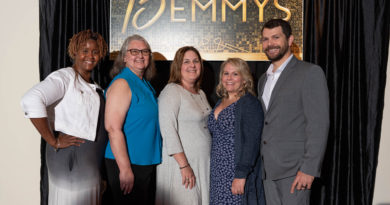Ed Yelin: A LIFE SHAPED BY LOVE
Story by H.D. Yelin
Photography by SUSAN DELOACH
Capitol Records, at the corner of Hollywood and Vine, has been housed in a building shaped like a stack of records (remember those?), with a stylus at the top. The penultimate floor was, in 1959, the home of the A&R Department: Producers charged with building the Artists and Repertoire of the singers, musicians, composers and arrangers who were good enough to be clients of the record company–whose co-founder was Johnny Mercer.
At the tender age of just-turned-30, Ed Yelin, a short, skinny, balding arranger from Buffalo, New York, moved into his dream office on that floor, and began a producing career that spanned decades. His first recording assignment was in the now-legendary Studio A, the perfect acoustics of which have preserved forever the work of Frank Sinatra, Nat King Cole, Woody Hermann, Stan Kenton (his mentor), Dean Martin, The Four Freshmen, Peggy Lee, Cannonball Adderley, Ray Anthony (known in the halls as “Ray Agony”), Miles Davis, Jo Stafford, Bobby Darin, Stan Freberg, Judy Garland, Nelson Riddle, Sue Raney (his wife at the time), Nancy Wilson—to name but a very few.
He didn’t record them all, but he knew them all—and countless more (Quincy Jones; Terry Gibbs; the Candoli brothers; Wayne Shorter; June Christy; Lester Young; George Shearing, Lionel Hampton—I can’t remember them all). He knew he had died and gone to heaven. How does a miracle like that happen?
Love. A relentless, unconquerable optimism. And a sense of humor that never, ever quits. I should know. I’ve been his wife for twenty-five years.
With a love of music that drove him, inspired him, thrilled him, overjoyed him, he started his career in the fourth grade, when he and his best friend Eddie Plant teamed up to perform the “Volga Boatman” trumpet duet for the school assembly. Rehearsing the night before, the two Eddies stood in front of a mirror, blowing their trumpets—not to perfect their technique, but to see who could make his face get redder.
Needless to say, they blew out their emboucheres. Once they took the stage, they could not blow a note—so, being nine, they put down their instruments and started fighting. As Mark Twain would say, let us draw the curtain of charity over this scene.
Eight years later, at 17, Ed enlisted in the Army, and was assigned to the band in the Army Air Corps. His job was usually to play Reveille—at a flagpole a mile from the barracks. He paid another guy $1 a day to do it for him—which may also explain why, when time came to drill, he was handed a wooden gun.
Nonetheless, after basic training at Lackland (San Antonio) and a temporary assignment outside at McClellan (Sacramento), he was sent to Washington, D.C., and was honored to play at Mount Vernon on Washington’s Birthday. Although he had grown up in Buffalo, he had never played his horn outside in that climate—and so did not know to keep his mouthpiece in his pocket. When he put his trumpet to his lips—again, he never got out a note.
A summer at Tanglewood followed, studying the twelve-tone scale with Arnold Schoenberg. He went on to study at Schillinger House (now Berklee School of Music) in Boston. His adoration of jazz took him to Manhattan, to hear Dizzy and Bird—and he was once and for all, terminally, hooked on the founders of Bebop, and the many great artists to follow. And he would know many of them.
But love—adoration, really- can be a tangling, mangling thing, as so many have learned. Ed volunteered to sing in a double-chorus, double-orchestra performance of Gustav Mahler’s Eighth Symphony at Carnegie Hall (I don’t know if it was Stokowski, or Bernstein conducting; either will do). The day of the performance, the opening note brought Ed to tears, and he wept all the way through it. Again, he did not get out a single note. Of course, he had a much better reason than 1) a busted embouchere, or 2) a frozen lip.
This may be when he began to turn from performance to production.
Notwithstanding his own performance issues—he could actually play the trumpet, under the proper conditions—he began arranging for Dave Garroway, on the Today Show in New York. But his dream was to produce at Capitol Records, in that far-off paradise, Los Angeles. Since he couldn’t see a way just to show up there and demand a job, he got as close as he could: As a salesman for Capitol in New York, peddling vinyl to radio stations, and occasionally taking artists around for interviews.One of those artists was Stan Kenton. In those hours in the car, talking jazz, something about Ed impressed Kenton—who went back to Los Angeles after one of those trips, and said to the Powers That Were, “You ought to hire that kid.”
A month later, Ed—who would forever after be “Kid” to Frank Sinatra—was one of six vice presidents for Artists and Repertoire on the penultimate floor of the exotic round building at Hollywood and Vine.
What makes a great music producer? A love of presenting everything—the artist, the song, the sound, the feel—at its best and highest potential. And that means, more often than not, showing humans that they are—and can be—better than they ever dreamed.
He did that for me, and turned me from a reformed lawyer into an A-list screenwriter. In the years at Capitol, he “passed” on “Eentsy-Teentsy Teen-Weeny Yellow Polka Dot Bikini”—and was proud of it. He was a founding member of NARAS, the National Academy of Recording Arts and Sciences, the home of the Grammys. He and his artists were nominated for many, and even won a few. He was approached by Herb Alpert and Jerry Moss to be a founding partner in A&M Records, and passed; not so proud of that, of course. But his optimism and sense of humor kept him from being envious, or jealous, or disappointed.
He went on to found his own production company, doing the music for many award-winning national advertising campaigns—Ford; Firestone; Dodge; Volkswagen; In’N’Out Burger. Even Fancy Feast cat food. (He says the crystal goblet was his idea. We’ll never know.)
Along the way, he became the proud father of two amazing sons—neither of whom is a musician, oddly enough—who to this day are as kind and loving to him as they can be.
At 85, he sometimes forgets some of his long and amazing career, but music always brings him joy (unless it’s my Golden Oldies from the 70’s—“Three chords,” he says. “It’s just the same three chords.”) Interestingly, the day he proposed to me, we heard the same song three times: Once in the car, once in a restaurant, and once in a nightclub. It became, of course, our song: Gershwin’s “Our Love Is Here to Stay”–and it has.
His life, his travels, his family, his dogs, his music—all have come to him through his great love for them, and stayed with him through his amazing, contagious happiness, and unfailing kindness. And so he has lived a life shaped by love. And miracle of miracles, he has given me one, as well.



